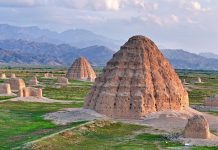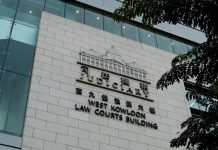Textile odyssey
Ni was born into a family deeply rooted in the silk industry in Shaoxing, Zhejiang Province, and his grandparents were skilled in mulberry cultivation and silkworm farming. “In my childhood, my hometown was surrounded by mulberry trees, and I used to walk through a forest of them on my way to school every day,” he told Beijing Review.
In 1991, after graduating from high school, Ni joined the Number Five Silk Factory in Shengxian County, Zhejiang. During that period, China’s foreign exchange reserves were low, and exporting silk textile products was a means to earn foreign currency. “During that era, the textile industry thrived, and silk weaving was a promising field,” he said.
Ni recalled that he had received training from the first day he entered the industry. He stood out among his peers and was frequently sent by the factory to leading garment enterprises to research the latest textile equipment and technologies.
Three years later, Ni was appointed as the head of a branch of a state-owned textile enterprise in Beijing. Unfortunately, the good times did not last. In the 1990s, with the restructuring of state-owned enterprises, many workers were laid off. However, despite losing their jobs at the factory, Ni and the master craftspeople in the factory decided to remain in Beijing to carry on the traditional silk weaving techniques, with Ni opening his own business.
In 2015, Ni established the museum to showcase Chinese traditional silk weaving culture. The museum exhibits traditional weaving equipment, textiles and techniques.
By collecting and restoring ancient looms, he hopes to replicate artifacts as faithfully as possible, rediscovering the ancient silk weaving techniques.
“I’ve been in this industry since childhood and I have a deep attachment to it. I hope to collect and restore as many traditional looms as possible, and leave behind more information for the silk industry, silk enthusiasts and scholars,” he explained.
“But there are very few ancient looms still in existence because traditional looms, being wooden, are not easy to preserve. That, coupled with their replacement by modern machinery, has seen most ancient looms gradually disappear,” he said.
Ni and his team have been building the collection of looms in two directions. First, they have recreated ancient looms by replicating unearthed models or according to other historical information. Second, they have collected traditional looms and fabrics from China’s remote regions.
He also created and dyed silk fibers by replicating ancient textile practices. He collaborated with universities and archaeological institutions on product development, academic exchanges and archaeological research.
After years of study and practice, he has gained a deep understanding of the historical origins of textiles throughout Chinese history and their production processes, and has become a highly respected textile restoration expert.
Textile mastery
According to Ni, the standards applied to weaving in ancient times far exceeded modern imagination, and achieving perfection in the production of ancient textiles was exceptionally challenging. In 2019, Ni participated in the replication of a Han Dynasty (202 B.C. to A.D. 220) woven armband called Five Stars Rising in the East, unearthed from the Niya ruins in Xinjiang Uygur Autonomous Region. The armband is one of the finest examples of Shu brocade, a brocade produced in the area around Chengdu, Sichuan Province, and is still in existence.
In modern times, fabrics with more than 100 warp threads per centimeter are considered high-density. However, the complete pattern of the Five Stars Rising in the East, 50 centimeters long, has 220 warp threads per centimeter. Each weft thread creates 2,200 intersections with the warp threads for every pass.
Ni was responsible for recording the data of this pattern, specifically, the intersections where each weft thread passes through the warp threads. The purpose was to illustrate precisely how each thread interlaced. After concluding his study, he wrote a total of 164 pages on the subject, providing intricate details on the fabric and the meticulous work of ancient artisans embodied in it.
“To produce such exquisite fabrics, the maker not only needs to be skillful in technique but also needs to have a very soft heart, operating with care,” Ni said. Therefore, in restoring these ancient textiles, Ni is meticulous.


Silk weaving techniques need to be passed down from generation to generation. Masters pass on their skills to apprentices, and apprentices learn gradually through practice. “But if no one teaches you, and you have to restore the technology yourself. It’s challenging to find the correct path for restoration,” Ni said, citing the example of the textiles unearthed from the Mawangdui Tombs, which were constructed in the Han Dynasty in Changsha, Hunan Province.
“If we hadn’t seen them with our own eyes, we would never have believed people 2,000 years ago could have produced such exquisite fabrics, as even with the most advanced technology today, they are difficult to replicate. However, the fabrics were made with what is now known to be a common silk weaving technique at that time, and similar textiles have been unearthed in many places. Due to the loss of this technique, we can’t replicate it, no matter what,” Ni said.
In addition to the loss of skills over the centuries, the lack of new craftspeople entering the industry is also one of Ni’s concerns. He noted that to become an excellent silk weaver, one must undergo a lengthy process. While mastering the technique takes three to five years, perfecting it is the work of a lifetime. “The heart and hands must be in harmony to create good textiles,” he emphasized. The early income in this field is not substantial, and even if someone can endure the long and tedious training, economic pressures may deter many young people.
Ni has been dedicated to passing on the skills to young people, providing internships for university students majoring in textile-related studies. He has also established extracurricular learning centers for primary and secondary school students, aiming to expose more young people to silk weaving culture. “If we don’t inject fresh blood, traditional silk weaving will be difficult to sustain. Young people have strong learning ability. I hope more young people will fall in love with traditional silk weaving techniques. In this way, traditional skills will be carried forward,” he concluded. –The Daily Mail-Beijing Review news exchange item





